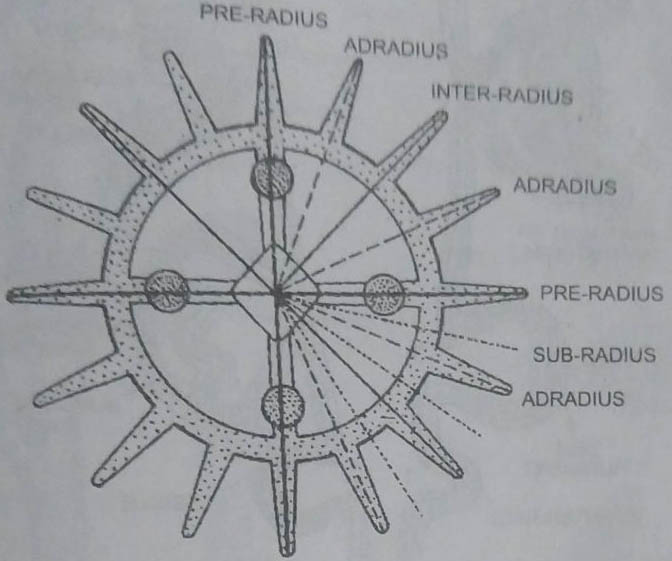Q. 3. Describe radial symmetry and the development of medusa Obelia.
Ans.3. Radial Symmetry
The medusa of Obelia shows radial symmetry in the following ways:
1. Four radial canals form the four principal radii. These are called per-radii. In young medusa, the four tentacles and the four corners of the mouth are found along the per-radii.
2. Inter-radii: These are radii of second-order and can be drawn by bisecting angles between any two per-radii. Four inter-radii tentacles are present on inter-radii.
3. Ad-radii: These are radii of the third order. These can be drawn by bisecting angles between per-radii and inter-radii. Eight adradial tentacles are found on these ad-radii.

4. Sub-radii: The angles between any two radii can again be bisected. These are called sub-radii or radii of the fourth-order. In the adult medusa, these also bear tentacles.
From the above account, it can be inferred that the medusa of Obelia exhibits radial symmetry.
Development of Medusa
In spring and summer, blastostyles produce medusae by asexual budding. During this period, these can be seen on a blastostyle in different stages of development.
Medusa-formation begins as a small protuberance in the wall of blastostyle. It soon enlarges into a vesicle and remains connected with blastostyle by a narrow stalk. Its cavity is continuous with that of blastostyle. Its wall has the same cellular layers as blastostyle. Thus it contains outer epidermis, mesogloea, and inner gastrodermis.
The apical epidermis of vesicle splits into two layers. The inner layer again splits to form a small cavity, the bell rudiment. The innermost epidermis and gastrodermis evaginate to form the rudiment of the manubrium. With the elongation of manubrium, outer epidermis gets broken. This two-layered broken epidermis becomes the shelf or velum. This projects inwards from the margin of the umbrella. Later, the mouth appears at the free end of the manubrium.
Later, the tentacles arise as finger-like outgrowths from the margin of umbrella. Finally, stalk connecting the medusa bud with blastostyle breaks and young medusa escapes through gonopore of gonangium. It now swims freely in the water.
